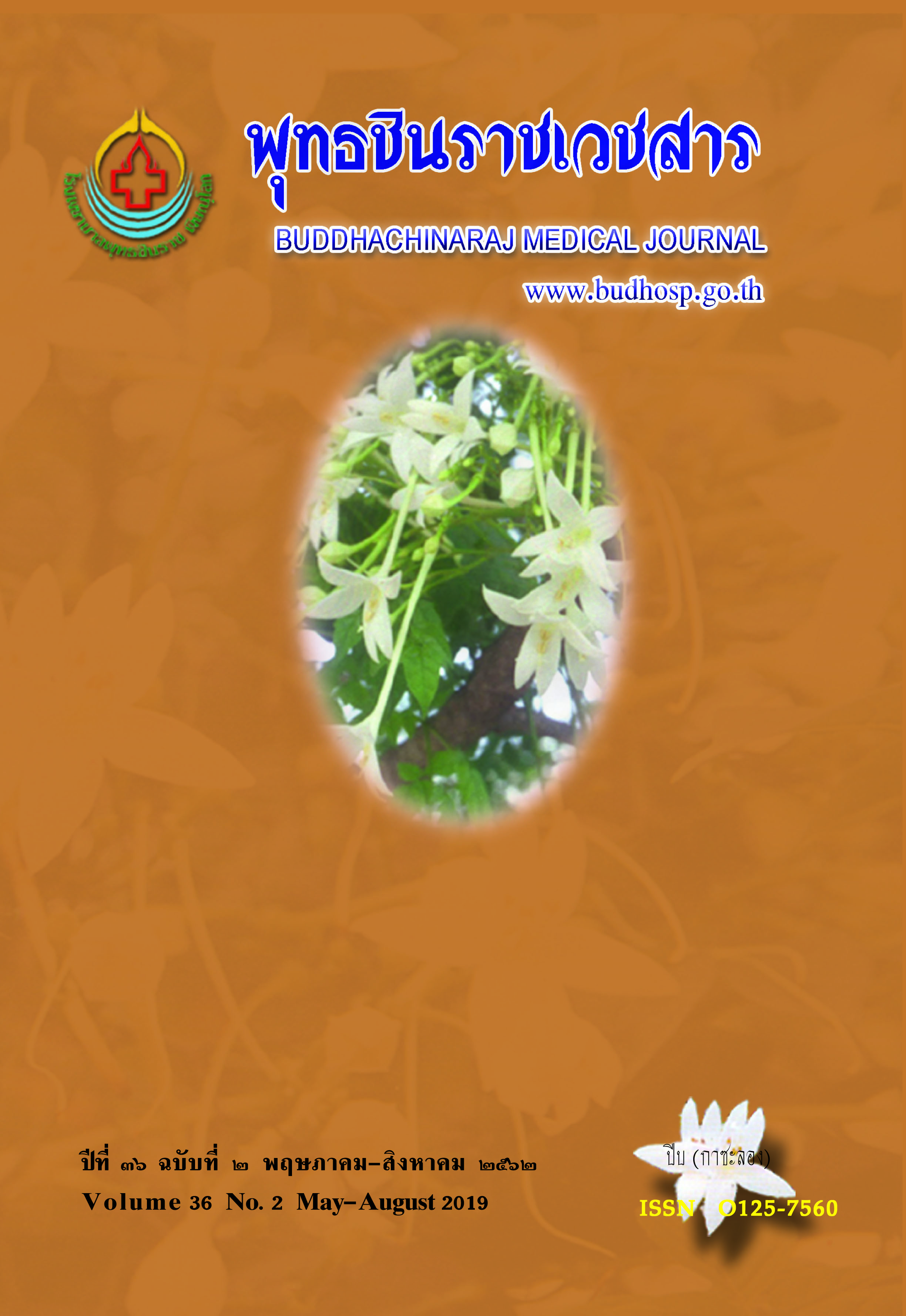การพัฒนาระบบการพยาบาลผู้ป่วยติดเชื้อในกระแสเลือดแบบรุนแรง
คำสำคัญ:
การพัฒนา, ระบบการพยาบาล, ผู้ป่วยติดเชื้อในกระแสเลือดแบบรุนแรงบทคัดย่อ
ผู้ป่วยติดเชื้อในกระแสเลือดแบบรุนแรงมีโอกาสช็อกและเสียชีวิต การวิจัยและพัฒนานี้มีวัตถุประสงค์เพื่อ พัฒนาระบบการพยาบาลผู้ป่วยติดเชื้อในกระแสเลือดแบบรุนแรงและประเมินผลลัพธ์ของการพัฒนาระหว่าง เดือนกุมภาพันธ์-กันยายน พ.ศ. 2562 ณ หอผู้ป่วยหนักอายุรกรรมและศัลยกรรม โรงพยาบาลพุทธชินราช พิษณุโลก การพัฒนาแบ่งเป็น 4 ขั้นตอน ขั้นตอน 1 วิเคราะห์ปัญหาและวางแผนพัฒนา ขั้นตอน 2 พัฒนาโดยสร้างแนว ปฏิบัติการพยาบาลผู้ป่วยติดเชื้อในกระแสเลือดแบบรุนแรงและพัฒนาระบบพยาบาลเจ้าของไข้ ขั้นตอน 3 นำระบบ ที่พัฒนาไปใช้ ขั้นตอน 4 ประเมินผลลัพธ์การพยาบาล วิเคราะห์ข้อมูลเชิงเนื้อหาและนำเสนอเป็นค่าความถี่ ค่าร้อยละ ค่าเฉลี่ย และค่าเบี่ยงเบนมาตรฐาน เปรียบเทียบข้อมูลด้วยการทดสอบ chi square, paired t และ independent sample t กำหนดระดับนัยสำคัญทางสถิติที่ 0.05 พบว่าคะแนนเฉลี่ยความรู้และสมรรถนะในการ ปฏิบัติการพยาบาลตาม Sepsis CNPG สูงกว่าก่อนการพัฒนาอย่างมีนัยสำคัญทางสถิติ จำนวนผู้ป่วยที่ได้รับ การตรวจปริมาณ lactate ในเลือดภายใน 1 ชั่วโมง ได้ส่งเลือดเพาะเชื้อ ได้รับยาปฏิชีวนะภายใน 1 ชั่วโมง ได้รับ สารน้ำทางหลอดเลือด ได้รับยากระตุ้นความดันโลหิต และอวัยวะที่ล้มเหลวฟื้นตัวหลังพัฒนามากกว่าก่อนพัฒนา อย่างมีนัยสำคัญทางสถิติ ดังนั้นผู้บริหารการพยาบาลควรใช้รูปแบบการพัฒนานี้ในการปฏิบัติการพยาบาลผู้ป่วย ติดเชื้อในกระแสเลือดแบบรุนแรงให้ครอบคลุมทั้งโรงพยาบาลเพื่อให้ผู้ป่วยปลอดภัยมากยิ่งขึ้น
References
2. Dellinger RP, Levy MM, Rhodes A, Annane D, Gerlach H, Opal SM, et al. Surviving sepsis campaign: International guidelines for management of severe sepsis and septic shock. Crit Care Med 2013;41(2):580-637.
3. Strategy and Planning Division, Ministry of Health. Health statistics. Bangkok: Strategy and Planning Division, Ministry of Health; 2018.
4. Ministry of Public Health. Health statistics [serial on the internet]. 2018 [cited 2018 Feb 12]. Available from: www.moph.go.th/
5. Strategy and Planning Division, Ministry of Health. Strategy nation planning twenty years in public health. Bangkok: Strategy and Planning Division, Ministry of Health; 2017.
6. Thiemsuwan Y, Malahom O, Indesuk T, Kwanchang P, Prasertsri N. The development caring system of critical sepsis patients by case management at Sunprasithtiprasong Hospital, Ubon Ratchathan. J Nurs Health Care 2017;35(1):184-93.
7. Briegel J, Mohnle P. Surviving sepsis campaign update 2018: the 1 h bundle; Background to the new recommendations/ Surviving Sepsis Campaign Update 2018. Der Anaesthesist [internet]. 2019 [cited 2019 Jun 22];68(4):204-8. Available from: http://search.ebscohost.com/login.aspx? direct=true&db=edsgao&AN=edsgcl. 581998592&site=eds-live
8. Naeng Na Suwan V, Nomkusol J, Tongjam R, Panaput T. The development of nursing system for severe sepsis patients. J Nurs Health Care 2014;32(2):25-36.
9. Harnyoot O. Nursing process and implications. J Royal Thai Army Nurses 2014;15 (3):137-43.
10. Leonardi BC. Patient deterioration: Early warning signs [internet]. 2014 [cited 2019 Sep 19]. Available from: https://www.rn.com/ nursing-news/patient-deterioration-earlywarning- signs/
11. Champunot R, Permpikul C, Patjanasoontorn B, editors. Medical practice guidelines for severe sepsis and septic shock, 2015. Bangkok: The Thai Society of Critical Care Medicine; 2015.
12. Levy MM, Evans LE, Rhodes A. The Surviving Sepsis Campaign Bundle: 2018 update. Intensive Care Med [internet]. 2018 [cited 2019 Jun 22];44(6):925-29. Available from:http://search.ebscohost.com/login. aspx?direct=true&db=edsgao&AN=edsgcl.
543909089&site=eds-live
13. Baig MA, Sheikh S, Hussain E, Bakhtawar S, Subhan Khan M, Mujtaba S, et al. Comparison of qSOFA and SOFA score for predicting mortality in severe sepsis and septic shock patients in the emergency department of a low middle-income country. Turk J Emerg Med [internet]. 2018 Dec 1[cited 2019 Apr 20];18(4):148-51. Available from:http://search.ebscohost.com/ login.aspx?direct=true&db=edselp&AN=S2452247318301341&site=eds-live
14. Doble MG. The new "Hour-One" sepsis bundle: Key takeaways and controversies [internet]. 2018 Jun 14 [cited 2019 Feb 12]. Available from: https://www.nursingcenter.com/ncblog/june-2018/hour-one-sepsisbundle
15. Aitken L, Schorr CA, Kleinpell R. Implications of the new international sepsis guidelines for nursing care. Am J Crit Care [internet]. 2013 [cited 2019 Jun 23];22(3):212-22. Available from: http://search.ebscohost.com/login.aspx?direct=true&db=edb&AN=87382416&site=eds-live
16. Canet E, Taylor DM, Khor R, Krishnan V, Bellomo R. qSOFA as predictor of mortality and prolonged ICU admission in Emergency Department patients with suspected infection. J Crit Care [internet]. 2018 Dec 1 [cited
2019 Jun 23];48(1):118-23. Available from:http://search.ebscohost.com/login.aspx?direct=true&db=edselp& AN=S0883944118307688&site=eds-live
17. Rhee C, Brown SR, Jones TM, O Brien C, Pande A, Hamad Y, et al. Variability in determining sepsis time zero and bundle compliance rates for the Centers for Medicare and Medicaid Services SEP-1 measure. Infect Control Hosp Epidemiol [internet].2018 [cited 2019 Jun 23];39(8):994-96. Available from: http://search.ebscohost.com/login.aspx?direct=true&db=edsbl&AN=RN617858403&site=eds-live
18. Khwannimit B, Bhurayanontachai R, Vattanavanit V. Comparison of the accuracy of three early warning scores with SOFA score for predicting mortality in adult sepsis and septic shock patients admitted to intensive care unit. Heart Lung [internet]. 2019
May 1 [cited 2019 Jun 23];48(3):240-4. Available from: http://search.ebscohost. com/login.aspx?direct=true&db=edselp&AN =S0147956318303340&site=eds-live
19. Marram G, Barrett MW, Bevis EO. Primary nursing: A model for individualized care. St. Louis: The CV Mosby; 1979.
20. Sangobon K, Seetalanuchit M. Development of a Primary Nursing Service System in the Intensive Care Unit of Saimai Hospital. EAU Heritage J Sci Technol 2015;9(3): 208-17.
21. Suranatchayanan P, Kenthongdee W, Kamonrat S. Nursing care system development for sepsis patients at Loei Hospital [internet]. J Nurs Health Care 2018;36(1):207-15.
22. Punvittayakool J, Maneeprai J. The development of care model for sepsis. J Nurs Divis 2018;45(1): 86-100.
23. Saengsanga P, Kiamkan N. Outcomes of using the clinical practice guidelines for patients with severe sepsis or septic shock care according to Sepsis Bundle Protocol at the ICU of Songkhla Hospital Thailand. Reg 11 Med J 2015;29(3):403-10.
24. Kowtrakool N. Effects of using a case management system to improve the quality of care for the sepsis patients in Sakaeo Crown Prince Hospital. Thai J Cardiothoracic Nurs 2014;25(2):120-34
25. Amphon K, Bunyoprakarn C, Sinkincharoen P. The outcomes of the development of the patients with septicemia, Prapokklao Hospital. J Prapokklao Hosp Clin Med Educat Center 2016;34(3):222-35.





